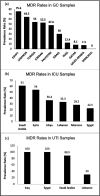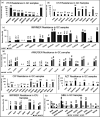Epidemiology of Multidrug-Resistant Pseudomonas aeruginosa in the Middle East and North Africa Region
- PMID: 34011686
- PMCID: PMC8265635
- DOI: 10.1128/mSphere.00202-21
Epidemiology of Multidrug-Resistant Pseudomonas aeruginosa in the Middle East and North Africa Region
Abstract
Over the last decades, there has been a dramatic global increase in multidrug-resistant (MDR) pathogens particularly among Gram-negative bacteria (GNB). Pseudomonas aeruginosa is responsible for various health care-associated infections, while MDR P. aeruginosa causes significant morbidity and mortality. Middle East and North Africa (MENA) represent an unexplored geographical region for the study of drug resistance since many of these countries are at crossroads of high volume of travel, diverse expatriate populations, as well as high antibiotic consumption despite attempts to implement antimicrobial stewardship programs. This minireview analyzes epidemiology, microbiological, and genomic characteristics of MDR P. aeruginosa in the MENA region. Published data on MDR P. aeruginosa prevalence, antimicrobial resistance patterns, and genetic profiles from studies published during the past 10 years from 19 MENA countries have been included in this minireview. There is wide variation in the epidemiology of MDR P. aeruginosa in the MENA region in terms of prevalence, antimicrobial characteristics, as well as genetic profiles. Overall, there is high prevalence of MDR P. aeruginosa seen in the majority of the countries in the MENA region with similarities between neighboring countries, which might reflect comparable population and antibiotic-prescribing cultures. Isolates from critical care units are significantly resistant particularly from certain countries such as Saudi Arabia, Egypt, Libya, Syria, and Lebanon with high-level resistance to cephalosporins, carbapenems, and aminoglycosides. Colistin susceptibility patterns remains high apart from countries with high-level antibiotic resistance such as Saudi Arabia, Syria, and Egypt.
Keywords: MDR; MENA; Middle East and North Africa region; Pseudomonas aeruginosa; antibiotic resistance; intensive care units; multidrug resistance; urinary tract infections.
Copyright © 2021 Al-Orphaly et al.
Figures



References
-
- Centers for Disease Control and Prevention. 2019. Antibiotic resistance threats in the United States. Centers for Disease Control and Prevention, Atlanta, GA. www.cdc.gov/DrugResistance/Biggest-Threats.html.
-
- European Commission. 2017. EU Action on antimicrobial resistance. European Commission, Brussels, Belgium.
-
- The Review on Antimicrobial Resistance. 2016. Tackling drug-resistant infections globally: final report and recommendations. The Review on Antimicrobial Resistance, London, United Kingdom. https://amr-review.org.
Publication types
MeSH terms
Substances
LinkOut - more resources
Full Text Sources
Other Literature Sources
Medical
Research Materials
Miscellaneous
